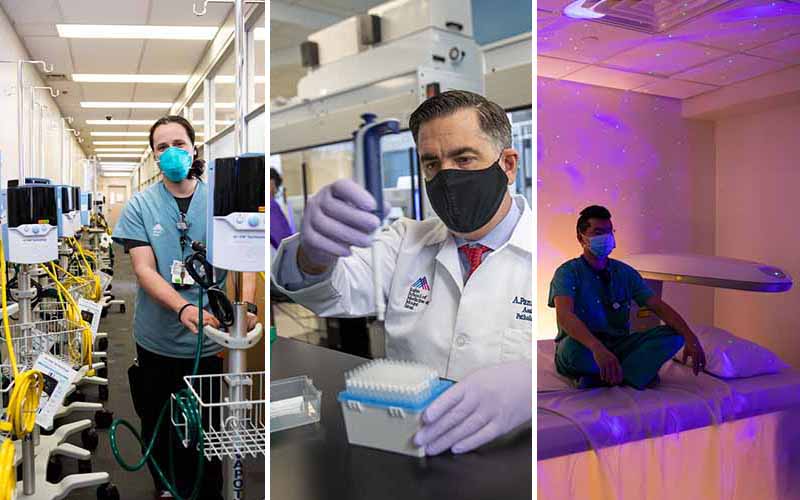 Before COVID-19 was even formally recognized as a pandemic, David L. Reich, MD, President of The Mount Sinai Hospital, was hearing from his anesthesiologist peers in Europe about a terribly problematic “respiratory disease” with a high mortality rate.
Before COVID-19 was even formally recognized as a pandemic, David L. Reich, MD, President of The Mount Sinai Hospital, was hearing from his anesthesiologist peers in Europe about a terribly problematic “respiratory disease” with a high mortality rate.
“This trusted source was telling me that people were getting very ill, and hospitals were becoming instantaneously overwhelmed with patients requiring intensive care,” said Dr. Reich, who is also Chief Clinical Officer of the Mount Sinai Health System.
“It got me thinking: if we fell into a crisis like that, do we have the structure to transform our hospital from the normal state where 15 to 20 percent of patients require ICU-level care, to one that is nearly 100 percent ICU and the next level down—intermediate care beds?” he said.
As Dr. Reich and Mount Sinai started to make contingency plans for the arrival of COVID-19 in New York City, he realized tackling a pandemic required creative and innovative solutions. Over the course of the COVID-19 pandemic—declared as such in 2020—Mount Sinai created various capabilities to tackle the crisis.
Dr. Reich discusses some of the things that were done at Mount Sinai to help provide relief to patients, the community, and the staff during the pandemic, and how those things have changed since.

David Reich, MD, President of The Mount Sinai Hospital
Clinical Command Center
During the pandemic, we needed to be able to move patients around seamlessly among hospitals, especially as one or more hospitals exceeded their capacity to provide care. Many things are involved in moving a patient from one hospital to another, and with hospitals traditionally managing their own admitting offices and with individual intake protocols, there were opportunities for miscommunication and inefficiency at a time when that would have cost lives.
We did away with the barriers and empowered our nascent Clinical Command Center to centralize admitting work and transfer protocols across all of our hospitals in the system. We needed a centralized view that looked at bed capacity and management, resource needs, and medical and protective supplies. The aim was to operationalize a group with a cohesive view of a health system, rather than silos, each thinking for themselves rather than optimizing for the benefit of all.
And because we tore down those barriers, we were able to see who needed help and to fill that gap in any way necessary. For example, when the leadership team of Mount Sinai Brooklyn simultaneously fell ill from COVID-19, we sent the Vice President of Perioperative Services from The Mount Sinai Hospital and a senior nursing leader to Brooklyn to be temporary leadership.
Today, the Clinical Command Center continues to add additional functions to support health system experts. We’ve learned that there are some hospital functions that are better suited to being centralized, not just for cost savings but also from an effectiveness standpoint. And there are some functions that are better suited to sit within each site.
Testing Labs
At the start of the pandemic, we needed to be able to do our own tests for COVID-19, rather than sending samples out to the city and state, because they had a six-day turnaround for results, which was impractical for the situation then.
Initially, we were using supplies from our basic science laboratories, but then Roche released a diagnostic platform that worked on one of our large-volume analyzers. Suddenly, we were able to achieve testing with a turnaround time under 24 hours that resulted in identifying which patients could be removed from isolation, saving precious personal protective equipment at a time of severe shortage.
And then, in December 2020, Bill Ackman, co-trustee of the Pershing Square Foundation, came to us and wanted to fund a project to bring kids back to schools. To do so, we needed a better testing mechanism. In partnership with Rockefeller University, we were able to implement a COVID-19 saliva testing program.
At the peak of the testing program, we were collecting from 700 sites a day, as far north as New Haven, Connecticut, and as far east as Montauk on Long Island to support employees of the Metropolitan Transportation Authority. We were also testing schoolchildren in Westchester County, NYC residents, multiple private businesses, and US Open tennis players and staff.
Now that the COVID-19 pandemic has receded, the equipment purchased using the Pershing Square Foundation grant is still being put to good use. Mount Sinai has a research study called the Mount Sinai Million Health Discoveries Program. When samples, such as blood, are collected from patients as part of their routine care, with their consent, researchers extract the DNA information as part of a genetic sequencing project. The massive database of genetic information will inform future diagnostic and therapeutic discoveries and help to design personalized treatment protocols.
Recharge Rooms
During the pandemic, our staff were very challenged by the high rates of patient mortality. It was a hard time. It was important for our staff to be able to take a break from the crisis, and people came up with the concept of recharge, or respite, rooms.
As we had limited resources, there was an idea to turn unused public spaces, such as family rooms or certain physiotherapy rooms, into spaces where our staff could sit in a peaceful environment. Some of these rooms had music, lighting, and even scents designed to reduce stress. Others were places where individuals could enjoy some quiet contemplation.
Today, many of these rooms have gone back to their original use to support our patients and visitors. A time of great crisis can spark great creativity, and as we work to lower barriers among our hospitals, I hope we access that creativity again and again.
